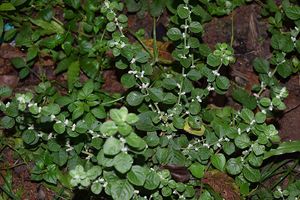Note: This is a project under development. The articles on this wiki are just being initiated and broadly incomplete. You can Help creating new pages.
Difference between revisions of "Rotula aquatica - Ashmahabhedah"
(→How to plant/cultivate) |
(→References) |
||
| Line 57: | Line 57: | ||
<ref name="chemical composition">[http://www.stuartxchange.org/Takad.html "medicinal plants"]</ref> | <ref name="chemical composition">[http://www.stuartxchange.org/Takad.html "medicinal plants"]</ref> | ||
<ref name="Leaf">[https://indiabiodiversity.org/species/show/230961 "india biodiversity"]</ref> | <ref name="Leaf">[https://indiabiodiversity.org/species/show/230961 "india biodiversity"]</ref> | ||
| − | + | ||
</references> | </references> | ||
==External Links== | ==External Links== | ||
Revision as of 17:08, 9 April 2018
Ashmahabhedah or Aerva lanata is a common weed which grows wild everywhere in the plains of India. The root has a camphor-like aroma.The dried flowers which look like soft spikes, are sold under the commercial names as Buikallan or Boor. It is one of the plants included in Dasapushpam, the ten sacred flowers of Kerala.
Contents
Uses
sudorific, diuretic, piles, diabetes, venereal diseases, kidney stone, bladder stones, cancer treatment, diuretic and laxatives, astringent.
Parts Used
Chemical Composition
Phytochemical study yielded alkaloids, flavonoids, phenolic compounds, steroids, and nutrients (amino acids and protein) - Roots have yield allantoin and a sterol, rhabdiol.[1]
Common names
| Language | Common name |
|---|---|
| Kannada | paashaanabheda |
| Hindi | pashanabhed |
| Malayalam | kallurvanci |
| Tamil | ceppunerinji |
| Telugu | pashanabhedi |
| Marathi | NA |
| Gujarathi | NA |
| Punjabi | NA |
| Kashmiri | NA |
| Sanskrit | ashmahabhedah |
| English | aquatica Rotula |
Habit
Identification
Leaf
| Kind | Shape | Feature |
|---|---|---|
| alternate | oblong-oblanceolate | Leaves alternate or fascicled, 1-2 x 0.5 cm |
.[2]
Flower
| Type | Size | Color and composition | Stamen | More information |
|---|---|---|---|---|
| solitary | calyx 3.5 mm long 5-partite | corolla pink | stamens 5 | Flowers are 5 mm long, 7 mm across, campanulate, 5-lobed. Carpels are five in number |
Fruit
| Type | Size | Mass | Appearance | Seeds | More information |
|---|---|---|---|---|---|
| 7–10 mm (0.28–0.4 in.) long pome | {{{6}}} |
Other features
List of Ayurvedic medicine in which the herb is used
- Vishatinduka Taila as root juice extract
Where to get the saplings
Mode of Propagation
How to plant/cultivate
The more common species of Aconitum are generally those cultivated in gardens, especially hybrids. They typically thrive in well-drained evenly moist garden soils like the related hellebores and delphiniums, and can grow in the shade of trees.
Commonly seen growing in areas
eastern trophical area, southern trophical, western trophical.
Photo Gallery
References
External Links
- Pages that are stubs
- Ayurvedic Herbs known to be helpful to treat sudorific
- Ayurvedic Herbs known to be helpful to treat diuretic
- Ayurvedic Herbs known to be helpful to treat piles
- Ayurvedic Herbs known to be helpful to treat diabetes
- Ayurvedic Herbs known to be helpful to treat venereal diseases
- Ayurvedic Herbs known to be helpful to treat kidney stone
- Ayurvedic Herbs known to be helpful to treat bladder stones
- Ayurvedic Herbs known to be helpful to treat cancer treatment
- Ayurvedic Herbs known to be helpful to treat diuretic and laxatives
- Ayurvedic Herbs known to be helpful to treat astringent
- Herbs with Root used in medicine
- Herbs with stem used in medicine
- Herbs with common name in Kannada
- Herbs with common name in Hindi
- Herbs with common name in Malayalam
- Herbs with common name in Tamil
- Herbs with common name in Telugu
- Herbs with common name in Sanskrit
- Herbs with common name in English
- Habit - Stout branching shrubs
- Index of Plants which can be propagated by Seeds
- Index of Plants which can be propagated by Tuber segment
- Herbs that are commonly seen in the region of eastern trophical area
- Herbs that are commonly seen in the region of southern trophical
- Herbs that are commonly seen in the region of western trophical



